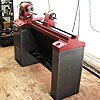I've heard people refer to the 5 cut method around here a couple times. What is this and how is it done. I saw a real cut-up version of it but still is a little off to me. Do you have to start with a square peice or does it matter? Some decent explaination would be great so I could really see how accurate my sleds and miter guage really is.





 Reply With Quote
Reply With Quote







